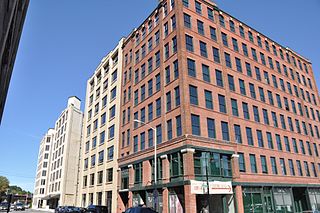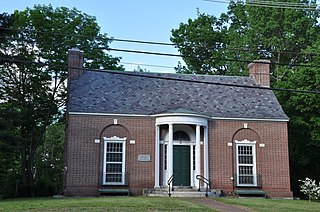
The Zimmerman House is a house museum in the North End neighborhood of Manchester, New Hampshire. Built in 1951, it is the first of two houses in New Hampshire designed by Frank Lloyd Wright, and one of a modest number of Wright designs in the northeastern United States. The house was built for Dr. Isadore Zimmerman and his wife Lucille. The house is now owned by the Currier Museum of Art because of the Zimmermans' decision to donate the home to the public after their death. The museum provides tours of the building, which is the only legal access to the grounds. It was listed on the National Register of Historic Places in 1979.

The Haverhill Board of Trade Building is a historic factory building at 16-18 and 38-42 Walnut Street in Haverhill, Massachusetts. The seven-story brick building was built in stages between 1906 and 1908 by the Haverhill Board of Trade, a consortium of local businessmen. The purposes of the building was to provide affordable factory space to small business operators, principally in the shoe manufacturing business that dominated Haverhill's economy in the early 20th century. The building also marked an expansion of Haverhill's business and industrial district into a previously residential area. The building was listed on the National Register of Historic Places in 2007. It has been converted to residential use.

The Lynn Realty Company Building No. 2 is a historic commercial building at 672-680 Washington Street in Lynn, Massachusetts. A long rectangular eight story brick building, it was built in 1902 to a design by local architect Henry Warren Rogers. The building is three window bays wide and seventeen long. Although it originally formally fronted on Washington Street, it extends on its long axis for most of a city block along Farrar Street. The original Washington Street entrance has been filled in, and the present entrance is now at what was the rear of the building, the southeast side, where there is a metal awning leading to a modern glass door. Windows on the street-facing sides are paired, with granite sills and header arches of a lighter-colored brick than the main body of the building. Brick pilasters rise between these paired windows the full height of the building, to a modestly-corbelled cornice.

The Story Grammar School is a historic school building at 140 Elm Street in Marblehead, Massachusetts. Built in 1880, it was the town's first modern graded school, and is a prominent local example of Colonial Revival architecture. It was named for a native son, United States Supreme Court Justice Joseph Story, and served as a public school until 1978. It is now in residential use. it was listed on the National Register of Historic Places in 1986.

District B is a historic worker housing district located in Manchester, New Hampshire, United States, near the former Amoskeag Manufacturing Company millyard. It is roughly bounded by Canal, Mechanic, Franklin, and Pleasant Streets, and was added to the National Register of Historic Places on November 12, 1982. It contains 32 contributing properties, including seventeen rowhouse tenement blocks built mainly between 1838 and 1850, in an area of approximately 170 acres (69 ha).

District D is a historic worker housing district located in Manchester, New Hampshire, near the former Amoskeag Manufacturing Company millyard. It is roughly bounded by Canal, Langdon, Elm, and West Brook streets, and was added to the National Register of Historic Places on November 12, 1982. It contains three residential buildings constructed in 1864 in an area of about 3 acres (1 ha).

The Kraus Corset Factory is a historic industrial property at 33 Roosevelt Drive in Derby, Connecticut, United States. The oldest portion of the large brick building, built in 1879, faces Third Street, while a c. 1910 addition extends along Roosevelt Drive. It is the only major building to survive from Derby's period of corset manufacturing. It was built by Sidney Downs, one of Derby's leading businessmen of the period. The building was listed on the National Register of Historic Places on February 12, 1987. It has been converted into apartments.

The Cummings Shoe Factory is a historic former factory building at 2 Railroad Avenue in South Berwick, Maine. Built in 1871, it house one of the town's major businesses until the 1990s, and as since been converted to residential use. The building was listed on National Register of Historic Places on December 31, 2001.

The Badger State Shoe Company is a classically-styled 6-story shoe factory built in 1910 in Madison, Wisconsin, a half mile north-east of the Capitol. It was added to the National Register of Historic Places on April 11, 1989.

Landis Shoe Company Building is a historic factory building located at Palmyra, Lebanon County, Pennsylvania. It was built in 1905-1906 and expanded in 1911, and is a three-story, brick building on a stone foundation. It is 26 bays wide by 4 bays deep.

The Charles H. Hayes Building is a historic former box factory at 14-44 Granite Street, Haverhill, Massachusetts. Built in two phases, the building represents the city's industrial growth around the turn of the 20th century. It was built by Charles H. Hayes, whose business empire also included locally important shoe manufacturers, as well as forest lands in four states to supply his operations. The building was listed on the National Register of Historic Places in 2010.

The L.H. Hamel Leather Company Historic District encompasses the largest tract of intact historical industrial buildings in downtown Haverhill, Massachusetts. The monumental factory complex of the L.H. Hamel Leather Company is located just west of Haverhill's central business district, and is roughly bordered on the west by the right-of-way for the former Boston & Maine Railroad, Essex Street on the south, Locke Street and Duncan Street on the east, and Winter Street on the north. The complex, which was built up between 1886 and 1929, was listed on the National Register of Historic Places in 2009.

The Boscawen Public Library is the public library of Boscawen, New Hampshire, United States. It is located at 116 North Main Street. The library's first building, built in 1913 to a Colonial Revival design by Guy Lowell, was listed on the National Register of Historic Places in 1981, and is slowly undergoing rehabilitation.

The Carpenter and Bean Block is a historic apartment house at 1382-1414 Elm Street in Manchester, New Hampshire. Built in 1883 and enlarged in the 1890s, it is a well-preserved example of a late Italianate brick tenement building. The building was listed on the National Register of Historic Places in 2002.

The Hoyt Shoe Factory is a historic factory complex at 470 Silver Street and 170 Lincoln Street in Manchester, New Hampshire. It consists of two once-identical four-story brick factory buildings which face each other across Silver Street. Built in the 1890s, they housed the city's largest shoe manufacturer, an industry that gained in significance as its textile industry declined. The complex was listed on the National Register of Historic Places in 1985.

The Roger Sullivan House is a historic house at 168 Walnut Street in Manchester, New Hampshire. Built in 1892, it is the only known example of residential Queen Anne architecture by local architect William M. Butterfield, and is one of the city's finest examples of the style. It was listed on the National Register of Historic Places in 2004.

The Exeter Waterfront Commercial Historic District encompasses the historic commercial and residential waterfront areas of Exeter, New Hampshire. The district extends along the north side of Water Street, roughly from Main Street to Front Street, and then along both sides of Water and High streets to the latter's junction with Portsmouth Street. It also includes properties on Chestnut Street on the north side of the Squamscott River. This area was where the early settlement of Exeter took place in 1638, and soon developed as a shipbuilding center. The district was listed on the National Register of Historic Places in 1980. It was enlarged in 1986 to include the mill complex of the Exeter Manufacturing Company on Chestnut Street.

The Woodbury Mill is a historic mill building at 1 Dover Street in Dover, New Hampshire. This five-story utilitarian brick mill building was built in 1885 by the Dover Improvement Association as a factory space for small footwear manufacturers to operate in, representing an organized effort by city businessmen to attract this type of business. It was used for shoe manufacturing until 1979, and was listed on the National Register of Historic Places in 2013.

The Queensbury Mill is a historic mill building at 1 Market Street in Somersworth, New Hampshire. Built in 1884, it is unusual for the period for its wood-frame construction, and for its financing, executed by local businessmen to attract shoe manufacturers to the city. The mill was listed on the National Register of Historic Places in 1987. The building has been converted into apartments.

George W. Stevens was an American civil engineer and architect practicing in Manchester, New Hampshire, during the nineteenth century.























